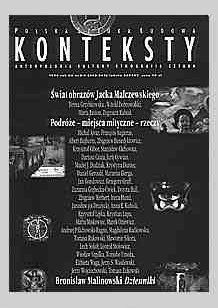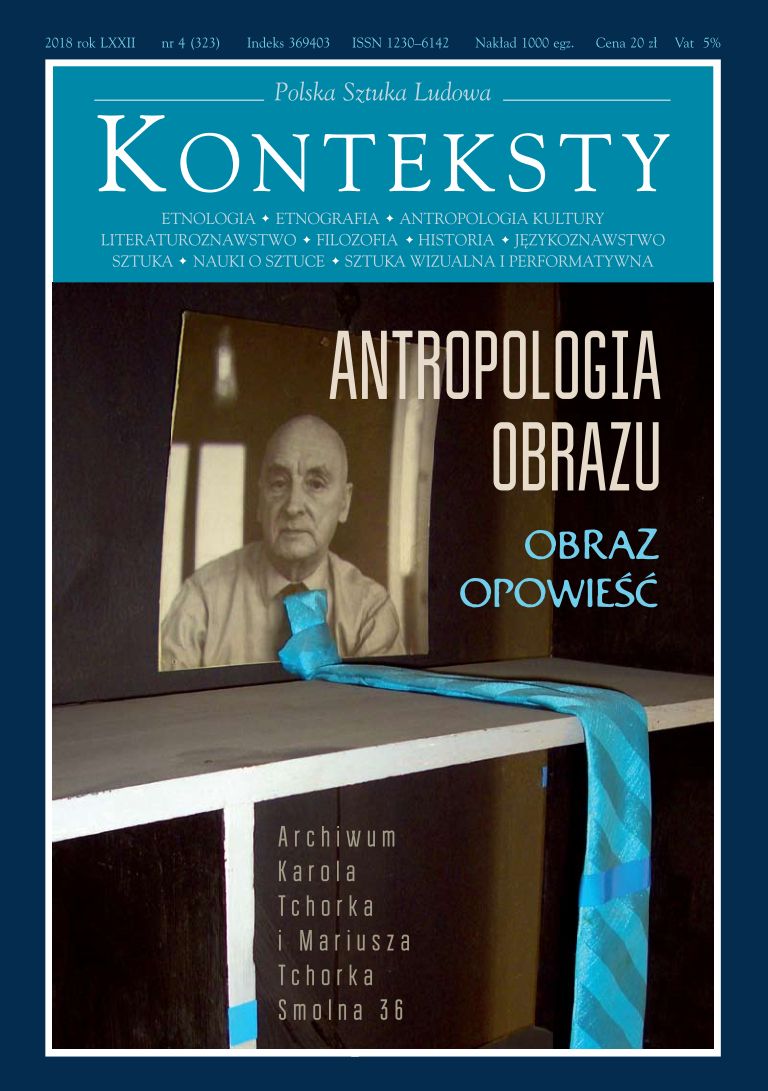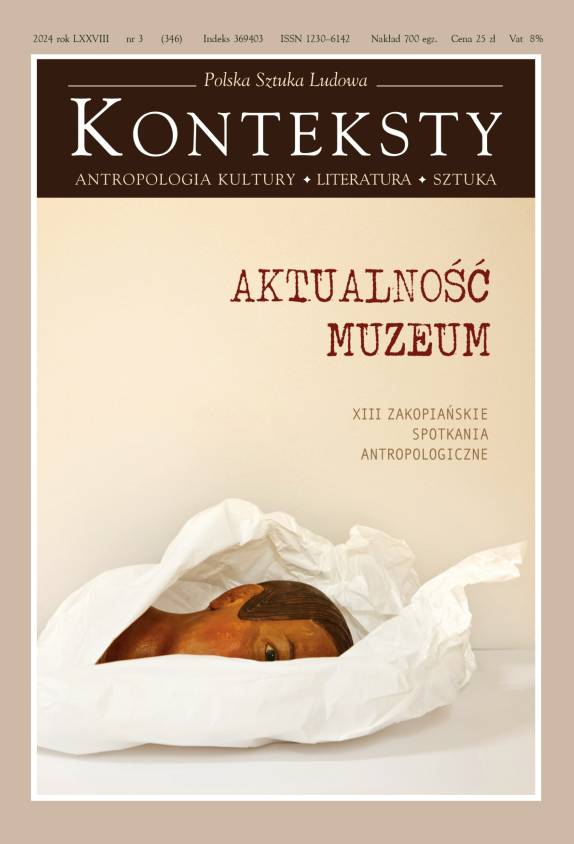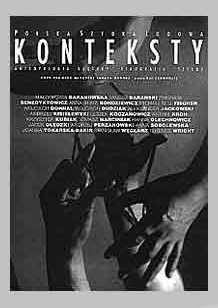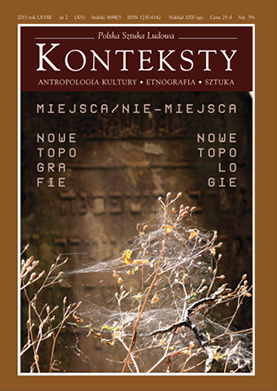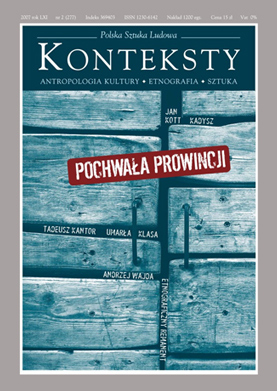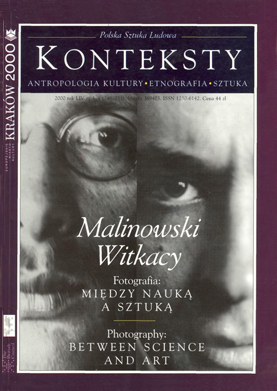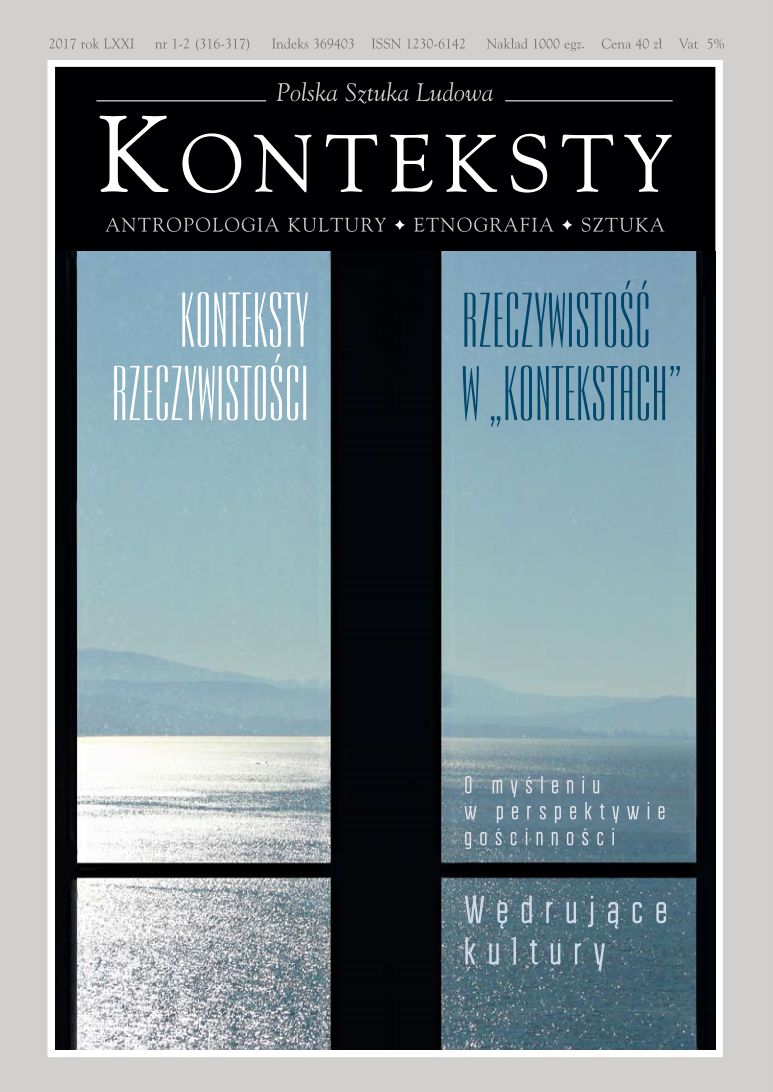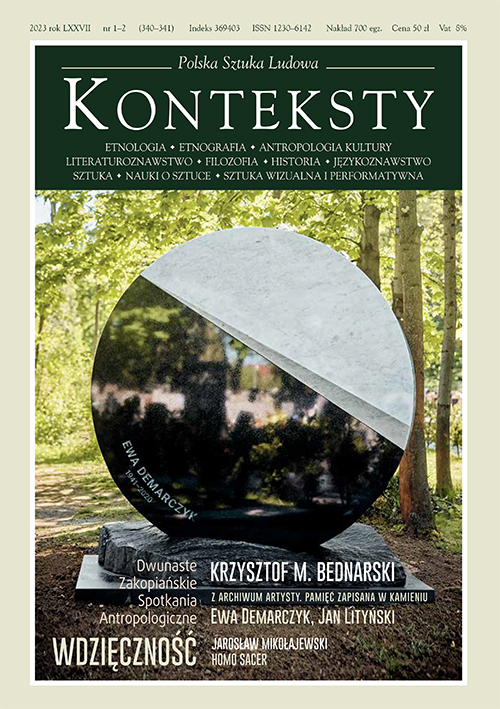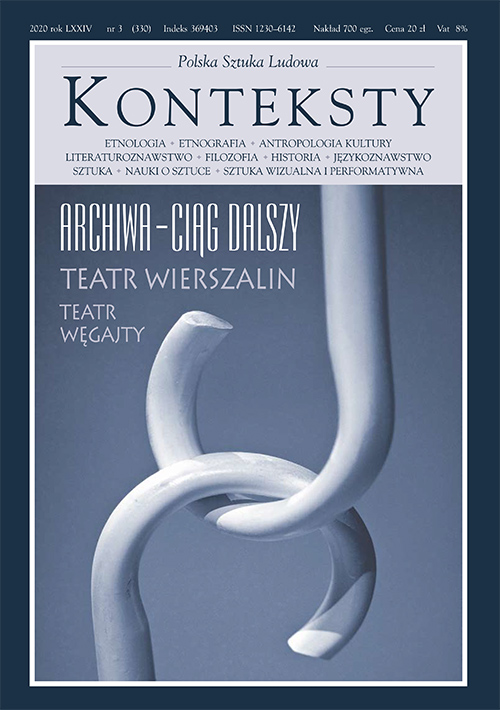Issue 2005/1 (268) -

| Zbigniew Benedyktowicz | Anthropology of Life. Anthropology of Death  | 3 |
A series of articles published in this issue of ”Konteksty” dealing with Peter Brook, the outstanding film and theatre director, who paid a visit to Poland in the first half of March 2005. The prime reason for the visit was the presentation of an honorary doctorate by the Adam Mickiewicz University in Poznań . This occasion was marked by a series of meetings held with the director in Poznań and Wrocław , as well as a staging of his most recent spectacle: Tierno Bokar. The texts contained in the quarterly comprise chiefly a documentation of the discussions and meetings organized upon the occasion of the spectacle and the doctoral degree ceremony. Additional material includes texts by professors-authors of opinions relating to the doctorate, and reviews of Tierno Bokar and Peter Brook’s Moving Point | ||
| Antoni Smuszkiewicz | Decani Orano | 7 |
| N. N. | Resolution on Granting an Honorary Doctorate, Passed by the Senate of the Adam Mickiewicz University in Poznań on 22 March 2004 | 8 |
| Dobrochna Ratajczakowa | In Between. The work of Peter Brook. Promotoris Laudatio | 9 |
| Georges Banu | For Peter Brook | 12 |
| Zbigniew Osiński | Transcultural Theatre of Peter Brook | 15 |
| Józef Tomasz Pokrzywniak | Citizen of the World. About Peter Brook | 19 |
| Peter Brook | Peter Brooks Speech | 23 |
| N. N. | Conversation with Peter Brook, March 6th 2005 | 25 |
| N. N. | Tierno Bokar | 26 |
| Marie-Helene Estienne | On Tierno Bokar | 27 |
| N. N. | Fragments of "Tierno Bokar" | 28 |
| N. N. | Why do you travel? Conversation with Peter Brook | 29 |
| Maciej Rożalski | What is truth - on Peter Brooks Tierno Bokar | 33 |
| Krystyna Duniec | Peter Brooks experiments | 39 |
| James Redfield | Classical Philology and Anthropology  | 42 |
Deliberations on the relations, mutual dependencies, and differences between anthropology and classical philology, pursued from the perspective of the author’s personal academic praxis. | ||
| Yannis Papadopoulos | The Triple «logos» of the Mythical Sphinx, or the Puzzle of Psychological Crossroads  | |
In the tragedy Oedipus the King Sophocles frequently returns to the crossroads, the site where Oedipus met and killed his father, Laios. The author of the article perceives this as a certain conceptual scheme making it possible to shape and describe man’s triple psychic structure, which in psychoanalytical categories corresponds to the consciousness, the subconsciousness, and the unconsciousness. This scheme (which also complies with the triple logos of the Sphinx) describes the stratification of Oedipus’ consciousness, and fortifies his tripartite psyche. While wandering along the three parting roads, he attained inner peace and gained a fully shaped personality, familiar with each level of his ego and, in a social dimension, the secret of a providential polis. | ||
| Dariusz Czaja | History is Naught? The Dilemmas of Contemporary Historiography  | 58 |
A presentation of Pamięć, etyka i historia (Memory, Ethics and History), an anthology of translations dealing with the theoretical problems of contemporary historiography. Meticulously compiled by Ewa Domańska, and containing an apt selection of texts, the book is an exceptional accomplishment in Polish humanities. Its rank is testified, on the one hand, by a representative choice of the authors who include such outstanding names as F. Ankersmit, H. White, and D. La Capra , and, on the other hand, by the, as a rule, high level of the dissertations relating to the fundamental and delicate epistemological questions of contemporary historiography. The review, written by an anthropologist of culture, underscores primarily those motifs and queries that are shared by historical and anthropological research. The reviewer emphasised the fact that both historians and anthropologists encounter the problems of representation, signature, authority, and art versus science. Hence the importance attached to historical solutions by anthropological literature. Texts by Ankersmit, La Capra and Gumbrecht were subjected to a closer characteristic, which entailed the resultant conclusions. | ||
| Aldona Mickiewicz | Two Vessels and Other Objects  | 69 |
The seventeenth century witnessed a growing popularity of portraying the five senses with the assistance of the still life. The best examples of this depiction of matter show the nature of experiencing matter, that” body of things” which confirms us in our own corporeality. Apparently, the more a given object is portrayed and described as individual, concrete, and extracted from amongst numerous other objects, the more it is perceived as symbolic. The symbol, in turn, manifests itself in a concrete form, the physical outer coating of matter. The artist is compelled to incessantly balance between his knowledge about the selected fragment of reality and that which he sees; artistic awareness assumes it shape somewhere on the borderline between knowledge, comprehension, pure (?) perception and wisdom. | ||
| Nina Király | Ars Poetica of Tadeusz Kantor  | 77 |
An introduction by a Hungarian theoretician of the theatre to a series of conversations with Tadeusz Kantor about painting and the theatre. | ||
| Tadeusz Kantor | To Speak About Death was Tactless. Art is Close to Death  | 84 |
A recorded statement by Kantor, from a interview conducted for the Hungarian „Studio” programme during his brief stay in Budapest in November 1989. The artist reconstructed the history of the establishment of his theatre and its theoretical premises, and spoke about, i. a. the origin and understanding of such concepts close to his art as reality of the lowest rank, „the poor theatre”, „the impossible theatre/monument”, and the „theatre of death”. | ||
| Jacek Leociak | A Meeting with a Cadaver in Two Acts  | 88 |
The author reflects on the iconographic and textual evidence of autopsy. This treatment of the human corpse, subjected to cultural models and social rules, is deeply enrooted in a medical, anthropological and philosophical discourse. Its characteristic features include the dynamic and variability of the discourse, associated with changes within the paradigm of knowledge about man. The article draws forth symptomatic properties of autopsies of the past, as well as their symbolic and anthropological meanings, predominantly ambivalence. The reader is offered a comparison of assorted manners of recording the experience of a „meeting with a cadaver” – graphic art and painting on the one hand, and poetic texts on the other. | ||
| Konstantin Biebl | 102 | |
| Gottfried Benn | 102 | |
| Stanisław Grochowiak | 103 | |
| Jean Clair | On Grossness in Contemporary Art. Fragment of the Book De Immundo. Apocastasis in Present-day Art  | 105 |
The author poses a fundamental question asking why contemporary art appears to be enthralled with the external aspects of the body, its products, inner fluids, and excreta. What sort of fascinations are expressed under the name of a work of art, considering that the art of the corporeal outer shell as well as the interior does not introduce anything new to the exploration of the human body. Never has art been so cynical, and to such a degree associated with scatology, impurity and filth; never before has the art of debasement been so highly esteemed by the heads of great cultural institutions in London, New York or Paris. | ||
| Bożena Stokłosa | Body and Art  | 112 |
A critical review of two books by I. Kowalczyk about the functioning of the body in contemporary art. The author draws attention to the inadequacy of theoretical language vis a vis a description of the discussed phenomena. Emphasis is placed on Kowalczyk dogmatic adherence to her own interpretation concepts, and a prevalence of postmodern theory (ideology) over an analysis of the art work, which takes into account historical reality. | ||
| Iwona Święch, Marek Janczyk | An Artist’s House. Words and Images  | 115 |
In this verbal-photographic essay the image is treated on par with the written word. The presentation concerns the home collection of Andrzej Różycki – photographer, director, and collector – brimming with works of folk art, especially sacral. The unusual atmosphere of the interior is created by lush vegetation which, together with bunches of dry herbs and flowers, expresses the union between Nature and art. Within this space Andrzej Różycki introduced his numerous collages composed of fragments of texts, photographs, and press cuttings, to illustrate his reflections on daily life. Everything which generates the ambience of this extraordinary house serves as a source of inspiration for the author’s art of photography, in which the theme of the house constitutes also a sui generis universe, pursued not particularly often but consistently within his entire oeuvre. | ||
| Wojciech Prażmowski | Places and Spiritus Loci – Travelling Across Poland Along the Trails of Pornografia by Witold Gombrowicz  | 122 |
An originally devised text by a photographer (written in the form of a letter), derived from the Berlin fragment of Dzienniki (Journals). The author confronts nostalgic fragments written from the perspective of the Berlin Tiergarten with his own stay in Berlin and subsequent journeys to the writer’s homeland. The text is accompanied by a vast photographic documentation of the Polish provinces. | ||
| Zbigniew Benedyktowicz | Poles, Poles – Visual Anthropology and Multiple Portraits by Krzysztof Gierałtowski | 129 |
| Jan Strzelecki | From Records, Letters, Notes. Sweden, Norway  | 151 |
A continuation of records and reflections by the author – a sociologist and passionate mountaineer – from his scientific stay in Sweden and Norway in 1988. | ||











